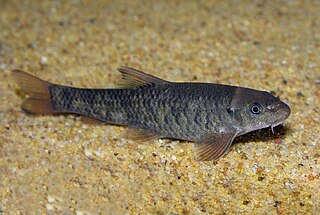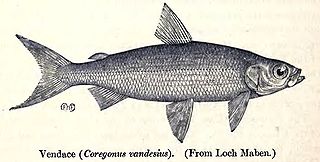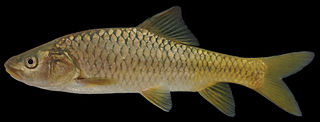
The red garra, also known as the doctor fish or nibble fish, is a species of cyprinid that is native to a wide range of freshwater habitats in subtropical parts of Western Asia. This small fish typically is up to about 14 centimeters in total length, but locally individuals can reach as much as 24 cm (9.5 in).

Coregonus vandesius, the vendace, is a freshwater whitefish found in the United Kingdom. Population surveys since the 1960s have revealed a steady decline and the fish is no longer present in some of its previous haunts but is still present in Bassenthwaite Lake and Derwent Water. The main threats it faces are eutrophication and the introduction of alien species of fish which eat its eggs and fry. The International Union for Conservation of Nature has rated its conservation status as "endangered".

The wildlife of Jordan includes its flora and fauna and their natural habitats. Although much of the country is desert, it has several geographic regions, each with a diversity of plants and animals adapted to their own particular habitats. Fossil finds show that in Palaeolithic times, the region had Syrian brown bears, Asiatic lions, zebras, Asian elephants, and rhinoceroses, but these species are all now extinct in this region.
Acanthobrama lissneri, or the Jordan bream, is a species of freshwater fish in the family Cyprinidae. It is found in Israel and Jordan. Its natural habitats are rivers and lakes, and is now commonly found in reservoirs.
The Albanian barbel is a ray-finned fish species in the family Cyprinidae. It is often referred to as "Albanian barbel" in a literal translation of its scientific name.

The Jordan himri is a ray-finned fish species in the family Cyprinidae.
The Jordan barbel is a species of ray-finned fish in the family Cyprinidae. It is found in Israel, Jordan, and Syria. Its natural habitats are rivers and freshwater lakes. It is threatened by habitat loss.

Garra is a genus of fish in the family Cyprinidae. These fish are one example of the "log suckers", sucker-mouthed barbs and other cyprinids commonly kept in aquaria to keep down algae. The doctor fish of Anatolia and the Middle East belongs in this genus. The majority of the more than 160 species of garras are native to Asia, but about one-fifth of the species are from Africa.
Garra ghorensis, the Jordanian log sucker or Dead Sea garra, is a species of ray-finned fish in the family Cyprinidae. It is native to Israel and Jordan, although it is no longer found in Israel. Its natural habitat is freshwater springs. It is threatened by habitat loss.
Garra kemali is a species of cyprinid fish, which is found only in Turkey, in swamps and freshwater lakes. It is threatened by a habitat loss.
Garra typhlops, also known as the Iran cave barb is a species of ray-finned fish in the family Cyprinidae. It is endemic to caves in Iran. Like other cave-adapted fish, it is blind and lacks pigmentation.
Garra widdowsoni, commonly known as the Iraq blind barb or Haditha cave garra, is a species of cyprinid fish endemic to underground water systems near Haditha in Iraq. Although traditionally placed in its own genus Typhlogarra, this is not supported by genetic evidence, leading to its move to genus Garra. This cavefish is considered critically endangered because of water extraction, which has lowered the groundwater level. Once abundant, a survey in 2012 found that it now was very rare. Another species from the same place, Caecocypris basimi, may already be extinct. The only other known cavefish in Iraq is Eidinemacheilus proudlovei.
Astatotilapia flaviijosephi, the Jordan mouthbrooder, is a vulnerable species of freshwater fish in the family Cichlidae (cichlids). It is found in the central Jordan River system, including Lake Tiberias (Kinneret), in Israel, Jordan and Syria, making it the only haplochromine cichlid to naturally range outside of Africa. This species is too small to be of significant importance to fisheries, unlike the only other cichlids native to the Levant, the economically important tilapias.

Tristramella simonis, the short jaw tristramella, is a vulnerable species of cichlid fish from the Jordan River system, including Lake Tiberias (Kinneret), in Israel and Syria, with introduced populations in the Nahr al-Kabir and Orontes basins in Syria. It prefers waters with little or no movement. Along with other tilapias, T. simonis is commonly caught as a food fish in parts of its range and it is commercially important in Lake Tiberias.

Cavefish or cave fish is a generic term for fresh and brackish water fish adapted to life in caves and other underground habitats. Related terms are subterranean fish, troglomorphic fish, troglobitic fish, stygobitic fish, phreatic fish, and hypogean fish.
Stenodus nelma, known alternatively as the nelma, sheefish, siifish, inconnu or connie, is a commercial species of freshwater whitefish in the family Salmonidae. It is widespread in the Arctic rivers from the Kola Peninsula eastward across Siberia to the Anadyr River and also in the North American basins of the Yukon River and Mackenzie River.
Oxynoemacheilus argyrogramma, the two-spot loach is a species of ray-finned fish in the genus Oxynoemacheilus. This species is found in the drainage of the Queiq River in Syria and Turkey, and the upper Euphrates drainage in Turkey and possibly in this drainage in Syria and Iraq. It has almost been extirpated from the Queiq as this river has virtually dried out but it remains abundant in the Euphrates. This species can be found in a wide range of habitats as long as there is a moderately fast current from small upland streams to banks of large rivers. It can also occur in stagnant water bodies such as reservoirs. It is threatened by water abstraction, lowering rainfall due to climate change and the construction of dams. The economic development of the area where this species occurs exacerbates these threats. Freyhof and Özuluǧ published a paper in 2017 that argued that Oxynoemacheilus euphraticus was a valid species and not a synonym of O. argyrogramma.
Angora loach is a species of ray-finned fish in the family Nemacheilidae. It is found in Israel, Jordan, Lebanon, Syria, and Turkey. It is found in Sea of Marmara and Black Sea from Simav east to Kızılırmak River drainages and drainages of Ilgin, Lake Akşehir and Lake Eber.
The Antakya minnow or Orontes golden barb, is a species of ray-finned fish in the genus Garra. There is some confusion regarding the identity of this fish. Formerly thought to be extinct, when occupying the Orontes watershed in Turkey, however a synonym, Hemigrammocapoeta caudomaculata is identified as least concern by the IUCN, and is found in the Asi drainage in Turkey and Syria and Nahr al-Kabir river on the border between Syria and Lebanon, and called the Asi golden barb. They are now considered to be the same species.
Garra jordanica is a species of ray-finned fish in the family Cyprinidae. This small fish, up to 10 cm (4 in) in standard length, is found in the northern Dead Sea basin, including the Jordan River system and Lake Kinneret, in Israel, Jordan and Syria. Populations in the coastal rivers of Kishon, Daliyya, and Taninnim have not been studied in detail, but may also be this species. In the past all these populations were included in G. rufa. Since the "G. rufa" seen in the aquarium and spa trade mostly are of Israeli origin, this leads to questions over their true identity. In the southern Dead Sea basin G. jordanica is replaced by the much rarer G. ghorensis.






